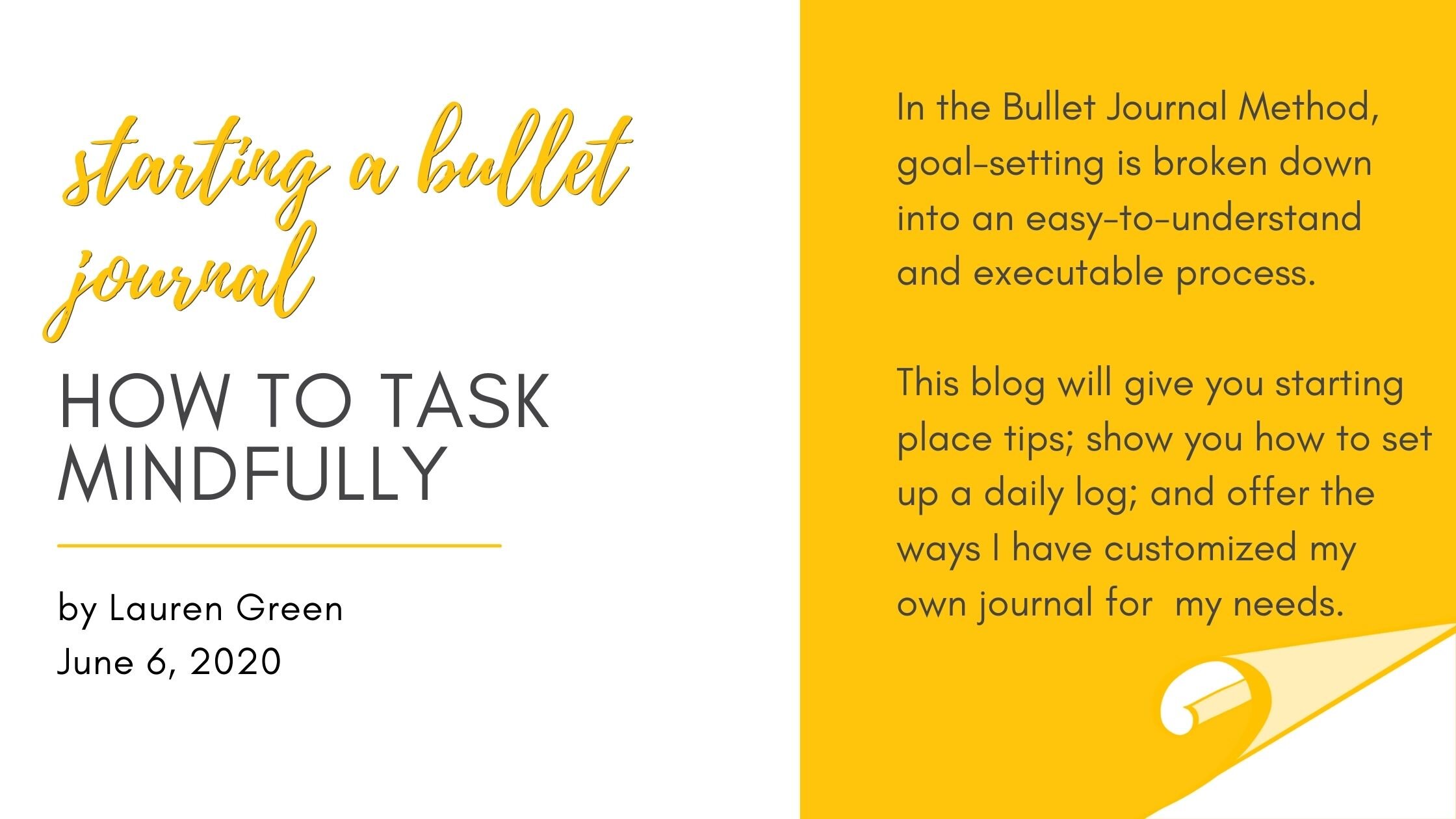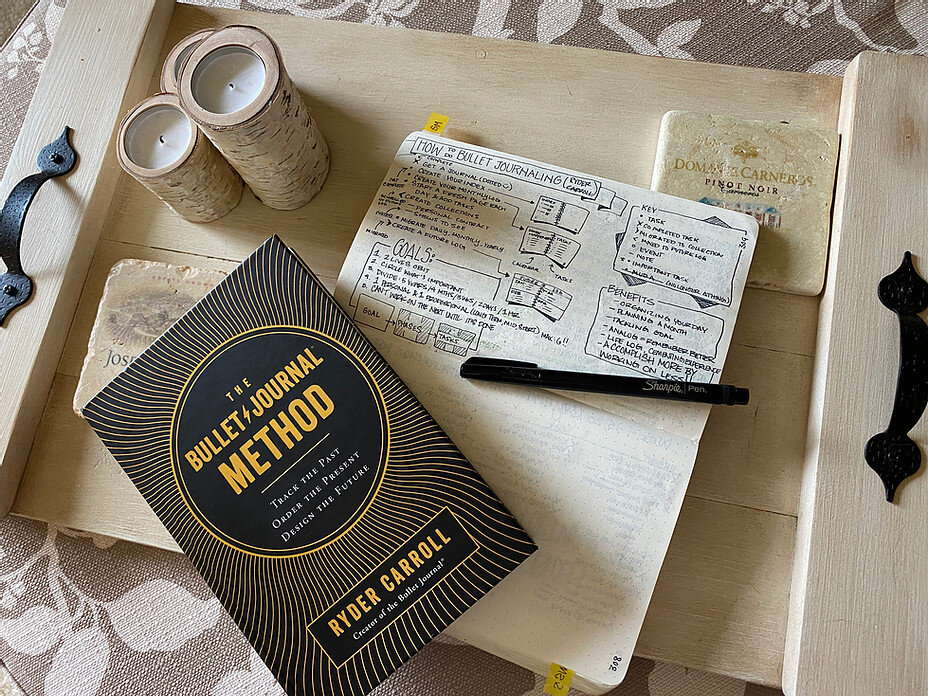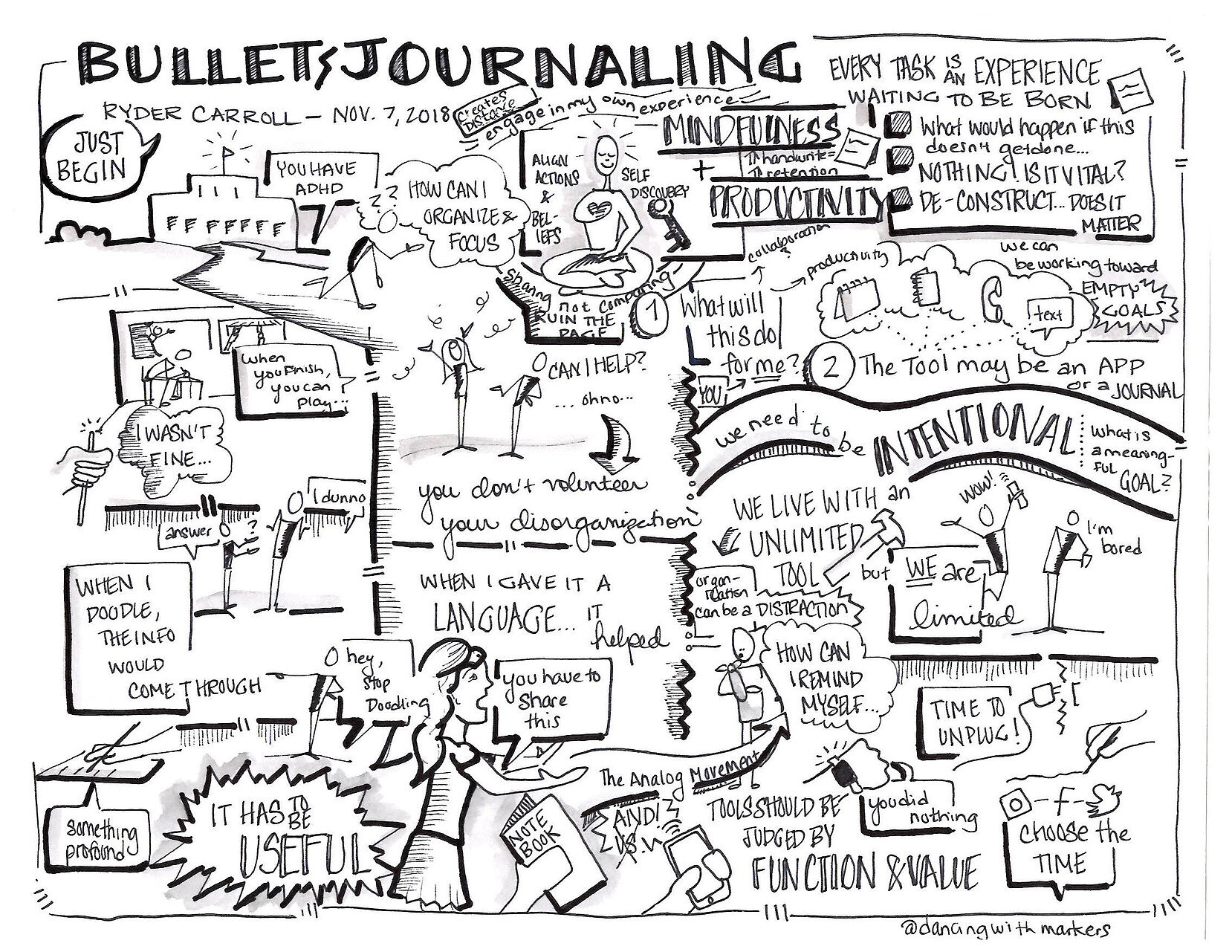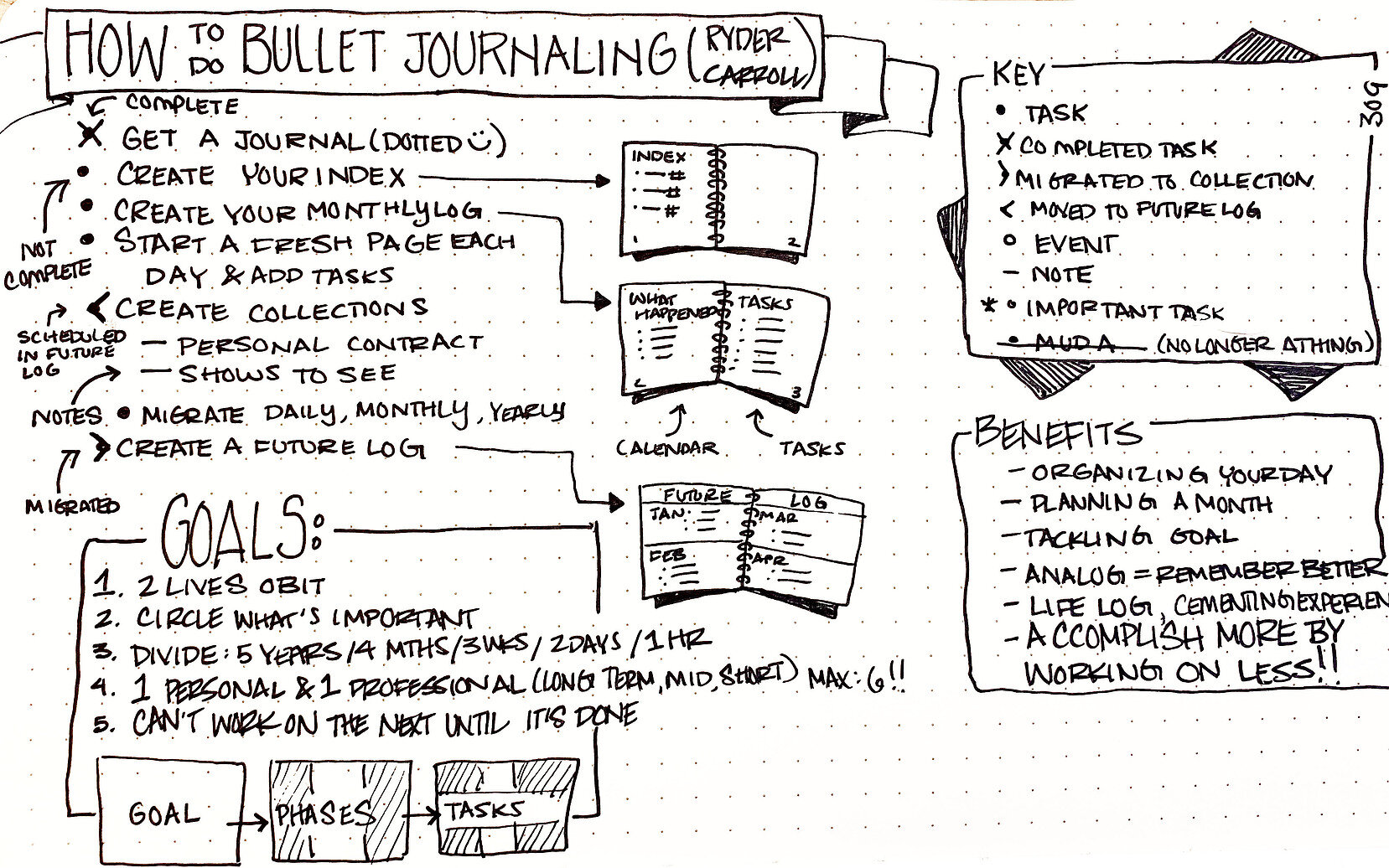Starting a Bullet Journal: How to Task Mindfully
The Bullet Journal Method invented by Ryder Carroll is a process for both long-term goal setting and planning, as well as day-to-day tasks. It's easy to lose energy when we pivot our dreams into actions. In The Bullet Journal Method, goal-setting is broken down into an easy-to-understand and executable process, that is grounded in unique individual visions and values. I will not go deep on all of the components of the method, but I will give you starting place tips; show you how to set up a Daily Log; and offer the ways I have customized my own journal for my needs.
It's not about total life disruption; it's about accomplishing more by working on less; making small changes that get you closer to where you want to be, while releasing what may be getting in the way. The Japanese call this kaizen. "Kai" translates to "change," while "zen" translates to good, continual improvement. In other words, good, continuous change.
The idea that busy-ness did not equal productivity made my head spin, at first. As an out-of-the-closet over-achiever, this was a big shift for me. The fact that it was okay and even more productive to have less to do or achieve ran counter to messages I had received academically and through my dance training. Once this idea sank in, it helped me relax a lot and set more reasonable, achievable goals. I even allowed some goals to fly away, because overtime, they were no longer serving my current ambitions.
By working in this focused way, we reduce "attention residue" that occurs when we start a new task before finishing the last one, a term coined by Dr. Sophie Leroy from the University of Minnesota. When we are less focused, we make less progress. The hope with The Bullet Journal Method is that we are able to maintain momentum more easily through focusing on what matters most, when it matter most. According to Carroll, happiness comes and goes. No one is perpetually happy. Happiness itself is not the goal, but rather the "result of action directed to our goals."
Bullet Journaling gave me a place to store my brain, so that I could turn it off and live. It helped me remember more through the process of writing and re-writing tasks, which made me feel like I had a real handle on my life and work. It helped me relax, knowing that I didn't need to focus on everything at once. Even in the most stressful moments, I knew that I could turn to a fresh page and sketch an idea, mind-map or brainstorm a challenge, and focus the time I had in a more meaningful way. I am innately more emotional and forgetful. Using this method has helped me manage my emotions, be more objective, and remember more. I hope this article serves to help you start your Bullet Journaling journey with confidence.
How I Learned About The Bullet Journal Method
It was a crisp fall evening in San Francisco in 2018. While in town for a workshop, my colleague Brian Tarallo and I were enjoying a stroll after our tradition of patronizing a local taco joint. We stumbled upon a little book store. The "hole in the wall" kind that you almost never see. We had to stop in. Upon completing our purchases, we noticed a sign by the register. "Book signing tonight with Ryder Carroll, author of The Bullet Journal Method ."
"We have to check this out," we said at the same time.
Later that evening, we enjoyed Carroll himself speaking about how the popular "Bullet Journal Method" originated. He talked about his struggles growing up with ADHD and finding that the practice of doodling helped him to focus. But as a child, he was told never to doodle.
As an adult, he eventually landed on his own way of taking quick short-hand notes that enabled him not only to remember his task list, but also feel more mindful and relaxed about what he needed to get done. His method allowed him to focus on what was most important and release what he no longer needed to do, enabling him to feel better and do more of what mattered.
Sketchnotes by Lauren Green (November 7, 2018)
Eventually, friends who were feeling challenged to find their focus amidst endless to-do lists picked up on the change in Carroll and asked him for help. They encouraged him to share the method, and overtime, it evolved into what is now a New York Times Bestseller and beloved productivity and mindfulness practice for many.
"Every task is an experience waiting to be born," Carroll said in his remarks. "We are limited and we need to be intentional."
Even after meeting Carroll, I did not immediately jump into Bullet Journaling. I had my own ways of organizing tasks through my email and reminders through my phone. However, about a year after this encounter, I was running a fully operational independent practice that became extremely overwhelming, in large part because I just didn't feel like I had a handle on what I needed to get done, or even if things that popped up on my task list were all that important. After an eye-opening therapy session, I gifted myself a personal date night to Barnes n' Noble, where I picked up my copy of the book, as well as a fresh, dotted Moleskin notebook .
Why a Notebook?
Organizing everything into a notebook means that you have everything you need in one place. There is a discipline involved when we work in this analog way. It is like a mental sanctuary, storing our thoughts, tasks and experiences; a place where we can go to reflect, as well as renew our intentions. Carroll reminds us that "ideas are born on scraps of paper." I have found myself using my journal to draft new business models and sketch out program ideas in a way that excites me more about the idea than typing it into a Word document.
Flipping back through the pages enables you to track your journey through time, reading a page by page record of your choices. Now you can easily see changes in your process and reflect on how you are feeling now versus when you started this journal.
"Holding onto thoughts is like trying to catch a fish with your bare hands," notes Carroll. We must externalize our thoughts and lists in order to de-clutter our minds.
Writing something by hand takes longer but improves our associative thinking, allowing us to make more connections between ideas, imprint the information, remember things better, and retain knowledge longer. Migrating, or re-writing tasks, is part of the process. Write each task until it is no longer needed or it is complete.
This is sort of like Marie Kundo's Tidying Up method. It takes more time and you curse her name every time you try to fold a fitted t-shirt into a "tiny rectangle," but it sure makes getting dressed a joyous experience, when you can quickly find what you need and see what you have.
Getting Started
The hardest part of starting any new habit is just getting started. The startup process below took me a week, while I was on a low-key vacation, but I would give this a good two weeks to a month, if time is limited.
Don't Google it. As soon as you Google "Bullet Journaling," you will be hit with many images of ornate and intimidating-looking daily task lists. It's wonderful if you enjoy making your lists pretty, but this is not the purpose of Bullet Journaling. You would never know that I'm a graphic recorder based on looking at my Bullet Journal.
Inventory your lists and where they are stored. Your lists could be hiding in your phone reminders, mobile notepads, sticky notes, Outlook reminders, spreadsheets, Google Drive, and more. The process of just figuring out where all your lists are stored can be a bear. Start your Bullet Journal by making a "Collection" (we'll go over what this term means later) of where everything is stored, so that you can build your Bullet Journal one page at a time.
Decide which lists you need all the time. Once you have a Collection of your lists, determine which ones are most important to your day-to-day life. These are the ones that get migrated into the journal.
Decide which lists don't go in. I still prefer to manage my calendar in Google, because it is shared with my colleagues and connected to my client-facing online booking portal. I also have a reading list that I will never finish in this lifetime. It is too long to rewrite every time I get a new journal. I store my master reading list on my Google Drive, and I have a Collection in my Bullet Journal, just for writing down books that others recommend. Then when I do my next journal, I "Migrate" the recommendations into the master and create a fresh reading list page in the new book.
Just start. As soon as you uncover a new part of the process, add it to your journal. It won't be perfect, and you will inevitably put ink on pages that you will later regret. Each time you start a new journal, you make it better. Allow the first one to be imperfect.
The Basic System
You really must get the book and read it cover to cover to get the most out of this method, but here are some ways to get start quickly.
Five Minute Tutorial
Lauren’s Quick Start Guide
A Bullet Journaling page about Bullet Journaling... how meta
A Few Key Components
Each of these components has a quick guide and visual on bulletjournal.com.
Index: The first four pages used as a Table of Contents.
Future Log: A place to put things that don't need to happen just yet.
Monthly Log: Two-page spread, with one calendar page and one task list page.
Daily Log: Your daily task list and rapid logging pages.*
Collections: A custom list.
Migrating: A practice of re-writing a task or list. Migrating happens, daily, monthly and with each new journal.
Rapid Logging: A short-hand way to capture your thoughts and witness your being.
What "The Bullets" Mean
= tasks
+ X = completed
+ > = migrated forward
+ < = backdated (or moved to a future time)
= events
+ X = completed event
Starting a Daily Log
Start each day with a fresh page and move yesterday's open bullets to this new page.
Open to a fresh new page and take a deep breath.
Write a short-hand date at the top (i.e. "MO 6.8.20" for Monday June 8, 2020).
Use the bullets to write out important tasks and events for the day.
Work through your list, "X"ing out each item or event, starting with the most (*) important.
The next day, migrate unfinished tasks and when you do, use the > on the previous day's list to indicate that the task has migrated.
Lauren's Custom Journal
Carroll encourages followers to make their journals their own, and that is why an empty, dotted journal, as opposed to a pre-filled planner, is recommended. Every person is unique, and your journal should be exactly what you need it to be for you. Here are a few ways I have customized the method to work for me.
Tabs. I like to add tabs, so I can quickly turn to the pages I use all the time.
Simple index. I only "Index" the pages I want to remember, not every single day or month.
Offer a reward for return. Mine is "$100.00 and a big smile."
Weekly list. Instead of a daily or a monthly list, I find that weekly lists better fit my needs. I always end my week on a Friday. I have four columns of tasks:
Urgent
Quick hits
Get ahead
Luxury (aka - nice to have)
Custom collections. I have custom Collection pages for:
Things I do every week
Things I do every month
Annual calendar for appointments, check-ups, and deadlines that happen quarterly, bi-annually and yearly.
Things to check in with Brian on (yes, Brian - you have your own page. It's page 7)
Workflow: client leads > proposals out > works in progress > invoices sent
"Best athlete chart" - colleagues I work with and what their key skill sets are
Supplies I need to purchase
Learning and continuing education ideas
Personal contract and decision model (check out our blog for how to make these)
Gift ideas for friends and family
Personal wishlist
Movies, shows, and theatre watchlist
Travel list
Bucket list
Local things to do
Recommended reads
Feedback from others
Blog and workshop ideas
Social media plan
Virtual collaboration tools to try out
Prompts to help you create a custom collection:
What do you uniquely need to remember or keep track of?
Who is in your life that you work with or support?
What hobbies do you enjoy?
FAQ's
How often do you create a new journal?
I go through a 400 page Moleskin every six months, which means about two journals a year. I begin creating the next one, when I've reached page 300.
What if my collection never changes? Do I need to keep writing it?
Some of my collections are always the same, such as the annual calendar. For these, I have them typed and ready to print on labels, so that I can quickly lay them into my next journal.
Why a dotted journal?
Dots allow you the most flexibility to make each page your own. You can draw lines and separators as needed for your custom lists, and you can ignore the dots completely in a way that is difficult to do with lined pages.
Is your journal for personal use or work use?
What's the difference? You have things you have to do in work and in your personal life. You are the only one who can decide what's most important to prioritize. For the most part, each of my Collections is a blend of both.
Home-joy:
Make a task list for today and your next two work days using the method.
Our Recommended Starter Kit:
- The Bullet Journal Method by Ryder Carroll
- Dotted notebook
- Sharpie pens
- Whiteout tape
- QUICK GUIDE: Bulletjournal.com
This article may contain affiliate and/or compensated links. For more information, please read our disclosure here.
If you enjoyed this article, please subscribe to our blog to receive email notifications whenever we post, and check out our events page for our coaching and workshop schedule.
DONATE:
If you loved this blog and want us to continue offering content like this, please consider donating to Dancing with Markers via PayPal.







